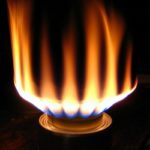It’s common for gas stoves to have a blue flame, but occasionally, you might notice a “red flame” appearing. A red flame indicates incomplete combustion, which results in lower heat output and slower cooking times. Prolonged cooking with a red flame can also cause discolored spots to form at the bottom of your pots and pans, affecting heat conduction and potentially damaging your cookware.

A gas stove with a red flame cooks food much slower due to reduced heat.
To address this issue, it’s important to identify the root cause and take appropriate measures.
There are two main reasons why your gas stove may be producing a red flame. The first is likely due to a clogged burner caused by dirt and debris. This is a common issue for older gas stoves. To fix this, follow these steps:
Start by turning off the gas stove and removing the burner grate. Next, lift and remove the burner head or cap.


For the small holes, use a toothpick or a thin wire to poke through and dislodge any built-up dirt or debris.


Once clean, make sure to dry the parts thoroughly.

Reassemble the burner head and grate, placing them back in their original positions.

Turn on the gas stove and observe the flame. It should now burn with a healthy blue color.

If the first method doesn’t solve the issue, the problem may lie with insufficient gas intake. In this case, you can adjust the regulator valve, which is located underneath the stove. Lift the stove top, and you’ll find the left and right stirrers, which control the left and right burners, respectively.

You can manually flip these stirrers with your hand until the flame turns blue.
By An Nhien – Vietnamnet
How to Handle a Red Flame on a Gas Stove
If you’ve noticed that your red flame cooktop has been cooking slowly and using a lot of gas, you should be aware of the potential danger. Over time, a black and sticky layer could form at the bottom of the pan – reducing its ability to transfer heat and risking permanent damage. Take quick action to prevent this from occurring.






































